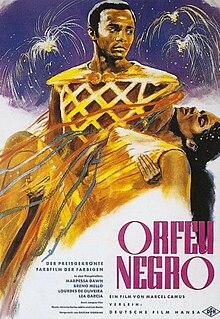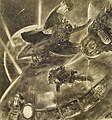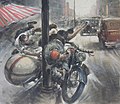Helmuth Ellgaard
Helmuth Ellgaard (born March 3, 1913 in Hadersleben , German Reich , † April 22, 1980 in Kiel ) was a German press draftsman and illustrator . He became known for his numerous movie posters, which he created between 1954 and 1961.
life and work
education
Helmuth Ellgaard was born in the then German Hadersleben. The parents belonged to the city's German minority. He was interested in drawing and painting from an early age. In 1928 the family moved to Kiel. In 1934 Ellgaard attended the technical and arts and crafts college in Kiel (today Muthesius Kunsthochschule ) and worked as a set designer at the Kiel City Theater and as a press illustrator for the Kieler Latest News . One of his earliest press drawings appeared on July 10, 1935 in the Kieler Neuesten Nachrichten and shows the renovation of the Kiel City Theater. His artistic role model at that time was the press illustrator Theo Matejko , whom he also offered a collaboration, but this was rejected.
War years
In 1939 Ellgaard went to Berlin , where he married the actress Lotte Berger . One son, Peter , was born in 1940, another, Holger, in 1943. Helmuth Ellgaard's work appeared in the Berliner Illustrirten Zeitung at Deutscher Verlag ( Ullstein Verlag during the Nazi era ). In 1940 he was awarded the Carl Schnebel Prize for “outstanding illustrative and press drawing achievements” for his portrayal of the “Greater German Struggle for Destiny” under the heading of Attention Low Flyers (title page of Sirene No. 11/1940). During the Second World War he was the official war correspondent in a propaganda company and followed as a lieutenant in the Air Force on many missions with his sketch pad.
Picture gallery, Helmuth Ellgaard
Before illustration for the 1936 Summer Olympics
post war period
During the years 1945–1948 Ellgaard illustrated, among other things, the youth magazine Ins neue Leben published by Minerva in West Berlin and the Neue Berliner Illustrierte and Die Frau von heute , both of which were published by the Allgemeine Deutsche Verlag in East Berlin . His clients included several book publishers, for example he illustrated adventures with the film camera by Paul Lieberenz (1946) or The Girl Fleur by Friedrich Berg (1946).
Helmuth Ellgaard left Berlin with his family in 1949 to move to Bad Tölz in Upper Bavaria . He was decisively involved in the creation of the illustrated magazine Revue , so he helped Helmut Kindler with a "handmade" zero number to get the necessary license for the publication of the magazine by the Allies. In 1952 the family moved to Munich . At the Revue he worked as a picture editor and press draftsman and illustrator until 1956. Almost every issue featured illustrations by Helmuth Ellgaard and much of this work was in the style of retro-futurism . The Upper Bavarian Alpine landscape also inspired Ellgaard to create numerous landscape pictures, which, however, were exclusively for private use.
After 1956 Ellgaard worked as a freelance press draftsman and illustrator, now living in Hamburg . Important clients were the film industry, for which he designed numerous posters, as well as magazines and book publishers, for example the film poster for Die Brücke in 1959, illustrations for serial novels, cheerful pictures of everyday situations and drawings of technical utopias.
His new role models were the American Norman Rockwell and the Dane Kurt Ard . He illustrated books for Ehapa Verlag and novels for Bastei Verlag . His work has appeared in Quick , Bunten , Heim und Welt , Kristall , Bild and many more. He was also known to the general public through his many film posters that reflect German films of the 1950s and 1960s, including B. the posters for the films And in the evening in the Scala and It happened in broad daylight .
Helmuth Ellgaard died of a heart attack in 1980 and found his final resting place in the Heikendorf cemetery near Kiel. Much of his work was given as a gift by his sons to the House of the History of the Federal Republic of Germany in Bonn in 2003 .
Picture gallery, works (selection)
War reporter: "Ich ramme", Berliner Illustrirte Zeitung , 1944
Title page “ Into New Life ” No. 11/1946
Election poster for the SED , 1947
"Traffic accident", Revue , 1952
Advertisement for NSU Prinz , 1958
Cover for Kristall magazine , 1958
Heinz Rühmann in the film " It happened in broad daylight ", 1959
Director Frank Wisbar , 1961
Lengede mine disaster , 1963
Movie posters 1954–1961



Sorted by time of origin, then the client / film distributor and web link to the poster if available.
The list is not yet complete and will be continued.
- 1954, Hell of Silverrock, Gloria Film
- 1955, Pelikan company, Gloria Film
- 1955, Shrove Monday , Gloria Film
- 1956, Terror, Gloria Film
- 1957, bank vault 713, Deutsche Film Hansa
- 1957, The silent Don, German film Hansa
- 1957, Made in Germany, Deutsche Film Hansa
- 1957, Be a great lady once , Deutsche Film Hansa
- 1957, Everything will be fine, Deutsche Film Hansa
- 1957, Malwa, Deutsche Film Hansa
- 1958, Grabenplatz 17 , Deutsche Film Hansa
- 1958, And in the evening in the Scala , Deutsche Film Hansa
- 1958, The girl from the Moorhof , German film Hansa
- 1958, The Star of Santa Clara, German Film Hansa
- 1958, rivals of the arena, Deutsche Film Hansa
- 1958, Petersburg Nights, German film Hansa
- 1959, spy for Germany, German London film
- 1959, Die Brücke , German film Hansa
- 1959, It happened in broad daylight , Deutsche Film Hansa
- 1959, A man walks through the wall , Deutsche Film Hansa
- 1959, dogs, do you want to live forever , German film Hansa
- 1959, An Angel on Earth, Deutsche Film Hansa
- 1959, night fell over Gotenhafen , German film Hansa
- 1959, Orfeu Negro , Deutsche Film Hansa
- 1959, And the woods sing forever , German film Hansa
- 1959, La Paloma , Deutsche Film Hansa
- 1959, Alt Heidelberg, German Film Hansa
- 1960, Björndal's legacy , Deutsche Film Hansa
- 1960, Der Greifer, German film Hansa
- 1960, hunter hunted
- 1960, A star falls from the sky , German film Hansa
- 1960, buy yourself a colorful balloon , Deutsche Film Hansa
- 1960, a millionaire who has a hard time, Deutsche Film Hansa
- 1960, loved by everyone, Deutsche Film Hansa
- 1961, Barbara, Deutsche Film Hansa
- 1961, The Miracle of Malachia , UFA Film Hansa
- 1961, Call of the Wild Geese, UFA Film Hansa
- 1961, Transport, UFA Film Hansa
- 1961, Only the Wind, UFA Film Hansa
literature
- Museum magazine. Foundation House of the History of the Federal Republic of Germany. No. 3/2003, ISSN 1433-349X , pp. 18-19.
See also
- Frederik Ellgaard , Danish painter
- Erik G. Ellgaard , American biologist
Web links
- HdG: Drawings by Helmuth Ellgaard - donation to the House of History.
- HdG: press photos drawings by Helmuth Ellgaard.
- Science fiction by Helmuth Ellgaard in retro-futurism
- Collection of other film posters by Helmuth Ellgaard at Poster Treasures
Individual evidence
- ^ Award certificate of the Carl Schnebel Prize
- ^ Press release of April 3, 2003 by the House of History of the Federal Republic of Germany
- ↑ Movie poster
- ↑ Movie poster
- ↑ Movie poster
- ↑ Movie poster
- ↑ Movie poster
| personal data | |
|---|---|
| SURNAME | Ellgaard, Helmuth |
| BRIEF DESCRIPTION | German press draftsman and illustrator |
| DATE OF BIRTH | March 3, 1913 |
| PLACE OF BIRTH | Hadersleben , Prussia |
| DATE OF DEATH | April 22, 1980 |
| Place of death | Kiel |























